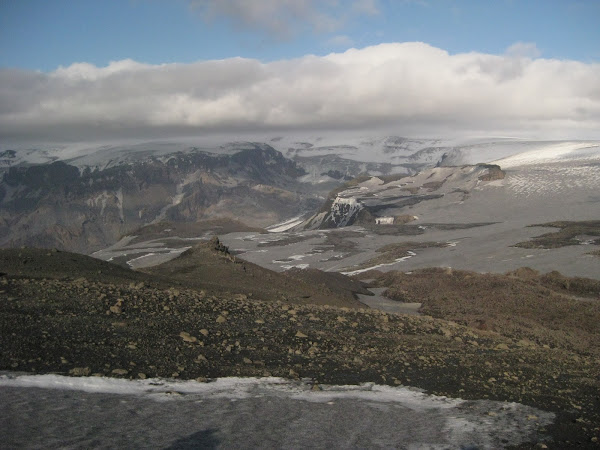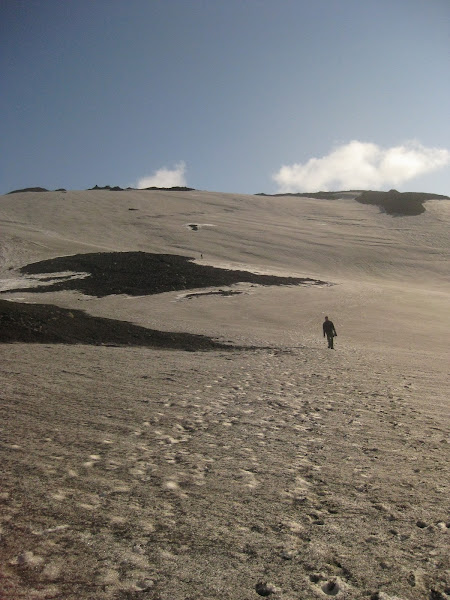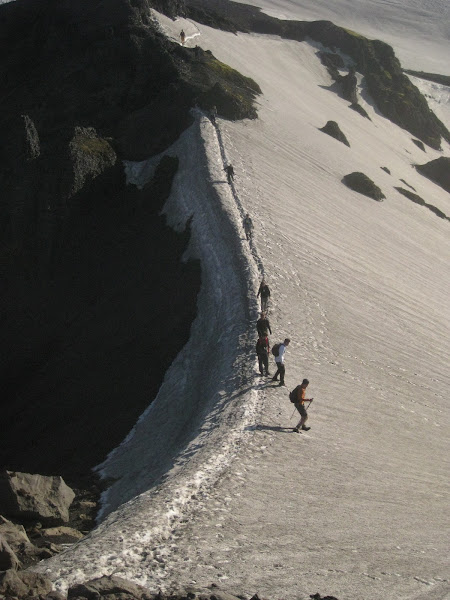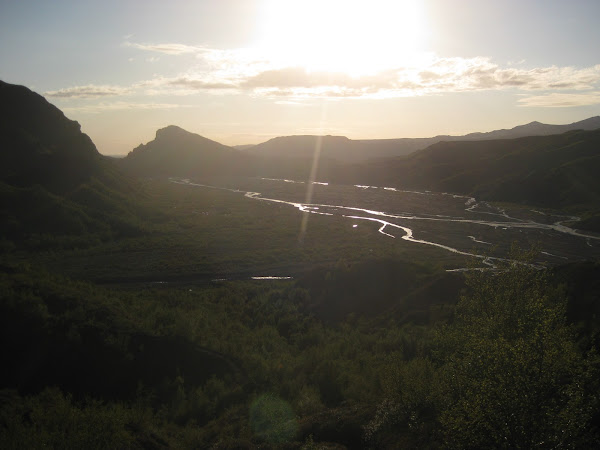We circumnavigate the volcano and the steaming hot land of magma turns quickly into a frozen horizon of ice once again. I learn from the professor about the concept of "dead ice:" ice that during an eruption has such a thick layer of ash fall on it that when the lava comes it can't melt the ice below before it solidifies. This creates a layer of ice the effective ground level that will never melt, hence the "dead" part.
The descent ahead of us is a wide open vista of hills, mountains, ice caps, peaks, valleys and basins, eventually leading towards our camping grounds at Þórsmörk, which I am told actually translates to "Thor's Forest." Everything is just so huge here that the sense of vertigo is overwhelming at times. I slowly begin to understand the concept of agoraphobia.

From near the volcano the long descent looks long and ominous, with no signs of civilization in sight.
We come to a fork in the footprints: one path follows the marked trail, the other goes down a steep hill of ice. The professor assures us it's safe - and a shortcut - so we take the latter. Beginning slowly, I build up speed going down the hill, bounding from one leg to the other, making long gashes in the soft, crunchy ice. I level out with a hopping slide that lasts far too long, a testament to the momentum I had build up.

Looking back at the massive ice hill we half-ran half-slid down.
Then we meet up with the trail again, and soon enough there is a rocky climb down to another ice hill. This one steeper looking than the first. The professor assures us that although there is no trail per se, if one went down the hill and followed the valley, one would arrive back at camp faster than following the trail. About half the group is daring enough to be persuaded by this supposed shortcut. I was happy to stay with the trail, and found myself pondering the leadership qualities of a professor who would gladly split a group of students in half when only he knows the terrain and none of us are equipped for an extended stay in the wilderness. You can doubtless guess what my conclusions were.

A perilous ledge made of only ice that we had to cross to continue the trail down.
The vast majority of our trip down was spent on the next leg: a dusty trail cut into the mountainside called the "Cat's Back." The name is very literal, and meant to conjure the image of a person trying to successfully balance across the spine of a feline. It is an apt name. At one point the gravel of the path slips beneath my feet and I slide for a couple inches along the ledge. Nothing gets your adrenaline pumping as much as harrowing moments like that.

The dusty Cat's Back Trail - the treacherous path set into the side of mountain.
When we finally get a glimpse of the Krossá river valley below it is washed in sunlight. My spirit soared at the uplifting feeling of having our destination in sight. It would take another couple hours of hiking to actually reach it, but just being able to see it was enough for a final spurt of energy to reach the bottom.

A first glimpse of the sun glinting off of the many rivers in the valley below, our future campsite nestled somewhere among them.
Terra firma never felt so good. It was another solid mile from the end of the trail to the actual camp ground. Twenty minutes of walking on a flat surface never felt so easy.
At the end of the hike I was exhausted both mentally and physically. My shoes were caked in mud, my feet freezing. I was sporting the worst blister of my life and my knee ached - though I've never had knee problems before. Despite all that, I felt truly triumphant when the day was over. I had conquered the beast (I estimate that with all our detours I hiked at least 16 miles), even if it took ten hours and every ounce of willpower I could summon.
I almost didn't have the energy to worry about the other half of the group - the one that opted for the "shortcut" down the second ice hill and into the valley. They did not beat us back as was expected. It was well over an hour later when they fumbled their way into camp from a completely different direction, delayed by getting lost and the lack of a clear trail. After we rejoined our companions there were a multitude of complaints and stories to be shared. It was good to have everyone back together in one piece. And for a moment, however briefly, I was utterly satisfied to do nothing but sit down and rest.